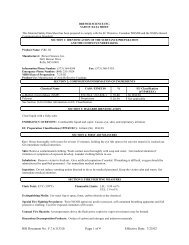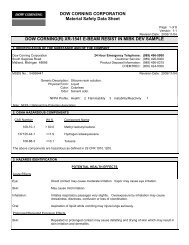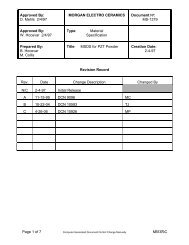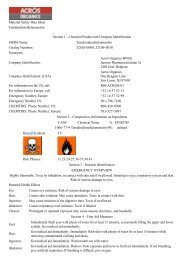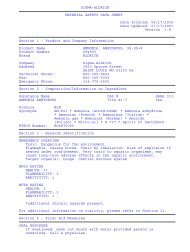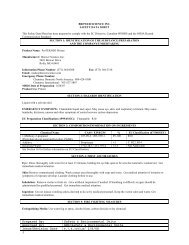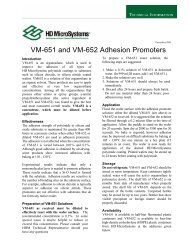MSDS M10 - Stanford Nanofabrication Facility
MSDS M10 - Stanford Nanofabrication Facility
MSDS M10 - Stanford Nanofabrication Facility
Create successful ePaper yourself
Turn your PDF publications into a flip-book with our unique Google optimized e-Paper software.
Beryllium Solid <strong>MSDS</strong> No. <strong>M10</strong> January 1, 2010<br />
screening or examinations should be conducted on individuals who may be exposed to further risk where<br />
handling and use of this material may cause exposure.<br />
Beryllium: The effects of chronic beryllium disease on the lungs and heart are additive to the effects of other<br />
health conditions.<br />
2.3 POTENTIAL ENVIRONMENTAL EFFECTS<br />
See Ecological Information (Section 12)<br />
3. COMPOSITION/INFORMATION ON INGREDIENTS<br />
CHEMICAL COMPOSITION (Percent by Weight)<br />
BRUSH WELLMAN PRODUCT<br />
CONSTITUENTS CAS Numbers Beryllium Solid<br />
Beryllium 7440-41-7 ~100<br />
Hazard Communication regulations of the U.S. Occupational Safety and Health Administration apply to this<br />
product.<br />
NOTE: As used in this Material Safety Data Sheet, the term “particulate” refers to dust, mist, fume, fragments,<br />
particles and/or powder.<br />
4. FIRST AID MEASURES<br />
4.1 FIRST AID PROCEDURES<br />
INHALATION: Breathing difficulty caused by inhalation of particulate requires immediate removal to fresh<br />
air. If breathing has stopped, perform artificial respiration and obtain medical help.<br />
INGESTION: Induce vomiting immediately as directed by medical personnel. Never give anything by<br />
mouth to an unconscious person.<br />
SKIN: Thoroughly wash skin cuts or wounds to remove all particulate debris from the wound. Seek medical<br />
attention for wounds that cannot be thoroughly cleansed. Treat skin cuts and wounds with standard first aid<br />
practices such as cleansing, disinfecting and covering to prevent wound infection and contamination before<br />
continuing work. Obtain medical help for persistent irritation. Material accidentally implanted or lodged<br />
under the skin must be removed.<br />
EYES: Immediately flush eyes with plenty of water for at least 15 minutes, lifting lower and upper eyelids<br />
occasionally. Get medical attention immediately.<br />
4.2 NOTE TO PHYSICIANS<br />
Treatment of Chronic Beryllium Disease: There is no known treatment which will cure chronic beryllium<br />
disease. Prednisone or other corticosteroids are the most specific treatment currently available. They are<br />
directed at suppressing the immunological reaction and can be effective in diminishing signs and symptoms of<br />
chronic beryllium disease. In cases where steroid therapy has had only partial or minimal effectiveness, other<br />
immunosuppressive agents, such as cyclophosphamide, cyclosporine, or methotrexate, have been used. These<br />
latter agents remain investigational. Further, in view of the potential side effects of all the immunosuppressive<br />
medications, including steroids such as prednisone, they should be used only under the direct care of a<br />
physician. In general, these medications should be reserved for cases with significant symptoms and/or<br />
Page 3 of 11



